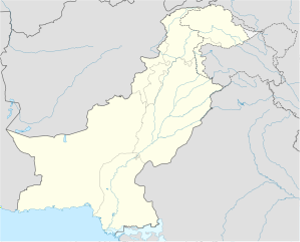Khaplu
Khaplu
ཁ་པུ་ལུ། (Balti) | |
|---|---|
Clockwise from the top: Khaplu Palace, Machulu Village, Bridge over Shyok River and Chaqchan Mosque. | |
| Nickname: Shyok valley | |
| Coordinates: 35°10′N 76°20′E / 35.167°N 76.333°E | |
| Country | Pakistan |
| Autonomous territory | |
| Baltistan division | Ghanche |
| Elevation | 8,500 ft (2,600 m) |
| Population | |
| • Total | 175,000 |
| Time zone | UTC+5 (PST) |
| • Summer (DST) | UTC+6 (GMT+6) |
| Website | Khaplu Valley, Skardu |
Khaplu (ཁ་པུ་ལུ།) is a city in northeastern Pakistan. It is the administrative capital of Ghanche District in Baltistan. The city is 103 km east of Skardu. It was the capital of the second-largest kingdom in Baltistan under the Yabgo dynasty. Khaplu served as a key point on the trade route to Ladakh and East Tukestan along the Shyok River. The city is a starting point for treks into the Hushe valley, leading to Masherbrum, K6, K7, and Chogolisa peaks.[1][2][3]
Khaplu is an ancient city and has many historic monuments and sites like the 700-year-old Chaqchan mosque and Khilingrong mosque, founded by Ameer Kabeer Syed Ali Hamadani, along with other tourist sites like Ehlie broq, Hanjor, ThoqsiKhar, Kaldaq, and the Shyok River.[4]
History
[change | change source]In the late 14th century, Syed Ali Hamdani came to Khaplu and converted people to Islam from Tibetan Buddhism and Bon. Many mosques and khanqahs attributed to him still exist.[5]
Khaplu was once an independent kingdom ruled by the Yabgo dynasty, the second-largest in Baltiyul after the Makpon Empire. In 1974, the rulers of Khaplu acceded their state to Pakistan, ending their rule of over a thousand years. In the 17th and 18th centuries, Khaplu had strong ties with Ladakh and Makpon (Skardu) due to the marriages between the Royal families.[6]
Captain Claude Martin Wade was likely the first European to visit Khaplu in 1835. Other travelers like William Moorcroft, George Trebeck, Godfrey Vigne, Alexander Cunningham, and Thomas Thomson explored and wrote about Khaplu's beauty and historical significance in the 19th and early 20th centuries.[7][8]
Related pages
[change | change source]References
[change | change source]- ↑ "Khaplu". www.tibet-encyclopaedia.de. Retrieved 2023-12-13.
- ↑ Unesco (1998-01-01). History of Civilizations of Central Asia. UNESCO. ISBN 978-92-3-103467-1.
- ↑ Kaul, Shridhar; Kaul, H. N. (1992). Ladakh Through the Ages, Towards a New Identity. Indus Publishing. ISBN 978-81-85182-75-9.
- ↑ Pakistan & the Karakoram Highway (7th ed.). Footscray, Vic. London: Lonely Planet. 2008. ISBN 978-1-74104-542-0.
- ↑ Rieck, Andreas (1995-01-01). "The Nurbakhshis of Baltistan — Crisis and Revival of a Five Centuries Old Community". Die Welt des Islams. 35 (2): 159–188. doi:10.1163/1570060952597761. ISSN 1570-0607.
- ↑ Kaul, Shridhar; Kaul, Hriday Nath (2004). Ladakh through the ages: towards a new identity (Third ed.). New-Delhi: Indus Publishing. ISBN 978-81-85182-75-9.
- ↑ Travels in the Himalayan Provinces of Hindustan and the Punjab in Ladakh and Kashmir in Peshawar, Kabul, Kunduz and Bokhara From 1819 to 1825 (in two volumes)Part II, p 264
- ↑ Jajja, Sumaira (2014-07-27). "Khaplu — off the beaten path". DAWN.COM. Retrieved 2023-12-13.






